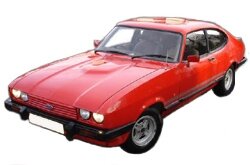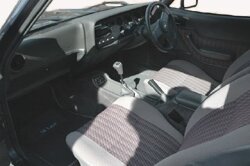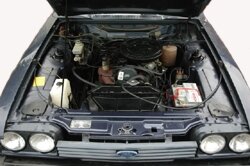Model Page
Ford Capri Laser

|
Production Run: |
N/A |
|---|---|
|
Production Date: |
1984 - 1986 |
|
Engine: |
Ford Pinto 1.6 OHC Ford Pinto 2.0 OHC |
|
Built: |
Cologne (Germany) |
|
0-60: |
1.6 - 11.4 Secs 2.0 - 10.8 Secs |
|
Max Speed: |
1.6 - 105 Mph 2.0 - 111 Mph |

Introduced in 1984 the Ford Capri Laser was the final run out model for the four cylinder Capri, Ford having decided to rationalise the model line up the Capri Laser replaced all other four cylinder models. With a choice of inline four cylinder 1.6 or 2.0 Pinto overhead cam engines and a full complement of extras the car proved a worthy stable-mate to the recently range topping Capri 2.8 Injection.

Ford Capri Laser Front View
Sales of the Capri’s had been in decline ever since 1973, by the early 1980’s volumes fell to a level whereby management started to think about ending production, some markets were requesting that they no longer wished to stock the car as volumes dropped critically low.
Ford decided that a new model would be launched – the model was known as the Capri Laser in Britain and in a move to rationalise Capri production and reduce factory complexity the car was designated to replace all other four cylinder models. It was decided that the Laser would be a high specification model with all optional extra’s available fitted to the vehicle, not only would this streamline production and cut costs but the car would become more aligned with the range topping 2.8 Injection.
The Capri Laser was given a visual makeover to bring the car up to date, the car came complete with colour co-ordinated wing mirrors (driver’s side being remotely operated), front grille and headlamp surrounds. Further revisions included the installation of tinted glass, bumper over-riders and a tailgate mounted rear spoiler in black – the latter also having the benefit of significantly increasing the aerodynamic efficiency. The exterior was complemented by the standard fit of four spoke RS Alloy wheels taken direct from the Capri 2.0 Sport. The exterior package was neatly finished off with new Laser side stripes and badges, these being of similar appearance to the Capri 2.8 Injection thus further bringing into line the entire range.

Ford Capri Laser Interior
Improvements did not stop there, the interior was given a minor update with a new seat design featuring the Truro II cloth and the model was fitted with an electronic radio cassette with electrically operated aerial. The gear knob and steering wheel were replaced with up-market leather trimmed items and the car benefited from the installation of the full six pod dashboard instrumentation. Finally the car was fitted with a tilt and slide steel sunroof.
The Laser provided no surprises mechanically with updates limited to the installation of a five speed manual gearbox or Ford C3 3 Speed Automatic gearbox as an option. The model continued to use the tried and tested front MacPherson strut with rear multi leaf spring suspension configurations. As development funds were limited the braking system was left untouched utilising front solid discs and drums at the rear.

Ford Capri Laser 1.6 ltr Engine Bay
The Capri Laser was only made available with the overhead camshaft Pinto range of engines in 1,593cc (1.6) or 1,993cc (2.0) capacities. The engine utilised a straightforward no nonsense uncomplicated design and proved both powerful and reliable in service. The 1.6 engine had a bore and stroke of 87.67mm x 66mm and was fitted with a Weber 32/36 DGV carburettor – in this configuration the car produced 88 bhp @ 5,700 rpm and 92 lb/ft of torque @ 4,000 rpm. Owners wanting more power and performance could opt for the 2.0 litre unit that had a bore and stroke of 90.8mm x 76.9mm, fitted with a Weber 32/36DGV Carburettor the engine developed 101 bhp @ 5,200 rpm and 112 lb/ft @ 3,500 rpm. Performance from both units was good with the 1.6 capable of reaching 60 miles per hour from standstill in around 11.4 seconds, the 2.0 litre unit achieving a slightly quicker 10.8 seconds to achieve this sprint. Top speed for the 1,593cc model was a respectable 105 Mph with the 1,993cc unit capable of just over 111 Mph.
Production of the left hand drive vehicle was ended in November 1984 when the Super GT (available with 2.0 and 2.3 V6 engines) was taken out of production. Manufacture of the right hand drive vehicles did not end at this point; Ford of Britain was more than happy to continue stocking the vehicle as sales remained relatively buoyant at over 22,000 vehicles. What was more was that the vast majority of these vehicles were sold to the private individual – these being at significantly higher margins that fleet sales.

Ford Capri Laser
As time progressed sales once again continued to slide and by 1985 only 11,000 cars were sold, product planners deemed that the model was no longer financially viable as costs inevitably rose with decreased volumes. Management put into motion plans for a final limited edition Capri to signal the end of production – the Capri 280 (sometimes referred to as the Brooklands Capri). The final Capri Laser rolled off the Cologne production line in November of 1986 as the model made way for the production of the final run out Capri edition – the Capri 280.
Nowadays the Capri Laser is starting to appreciate in value, the model offers prospective owners high standards of fit and finish for reasonable outlay for a car of this age. Once a regular site on British roads the Capri is becoming increasingly scarce and prices are reflecting this, good quality Laser Capri’s can fetch in excess of £5000 although the general price range is between £1,000 and £3,000.
The Facts
|
Engine: |
Ford Pinto Overhead Cam In Line 4 |
|---|---|
|
Capacity: |
1,593cc 1,993cc |
|
Valves: |
8 |
|
Compression Ratio: |
1.6 - 9.2:1 2.0 - 9.2:1 |
|
Fuel System: |
32/26 Weber DGV Twin Choke Carburettor |
|
Maximum Power: |
1.6 - 88 bhp @ 5,700 rpm 2.0 - 101 bhp @ 3,500 rpm |
|
Maximum Torque: |
1.6 - 92lb/ft @ 4,000 rpm 2.0 - 112 lb/ft @ 3,500 rpm |
|
Transmission: |
Manual 5 Speed / Option Ford C3 3 Speed Automatic |
|
Top Gear: |
21.4 mph per 1000 rpm |
|
Brakes: |
Servo Assisted Font Discs / Rear Drums |
|
Kerb Weight: |
1.6 - 1007 Kg 2.0 - 1032 Kg |
|
Max Speed: |
1.6 - 105 Mph 2.0 - 111 Mph |
|
0-60: |
1.6 - 11.4 Secs 2.0 - 10.8 Secs |






